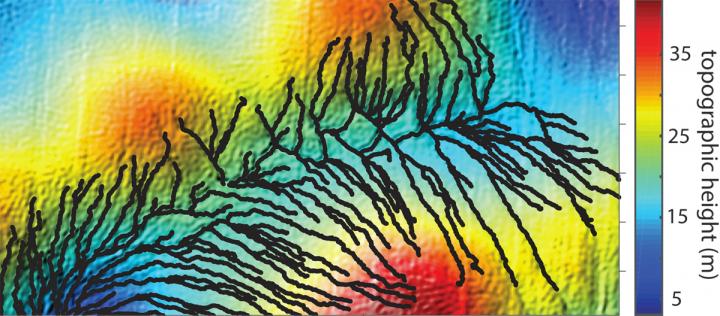Summer melt-driven streams on Greenland's ice sheet brought into focus

Graphic shows a drainage system view that is overlaid on a satellite image of a portion of Greenland's ice sheet during the movement of summertime meltwater moving from high elevations downward to the sea. Courtesy of Leif Karlstrom
Erosion by summertime melt-driven streams on Greenland's ice sheet shapes landscapes similarly to, but much faster than, rivers do on land, says a University of Oregon geologist.
The approach used to study the ice sheet should help to broaden scientific understanding of melt rates and improve projections about glacial response to climate change, says Leif Karlstrom, a professor in the UO Department of Geological Sciences.
The study, online ahead of print in the journal Geophysical Research Letters, also found that the topography of Greenland's bedrock below the slowly flowing ice sheet has a role in the formation of basins in the ice above as high-elevation streams make their way downward toward the sea.
“How fast is the ice sheet melting, and how much the melt will contribute to rising sea levels are important questions,” Karlstrom said. “It is important to quantify the melt rate, but that is not easy. Our study allows us to use geometric characteristics of the channel network — their patterns on the landscape — as a diagnostic tool.”
Projections on sea-level rise, such as those done with remote sensing or satellite observations, he said, have been difficult to determine accurately because melt rates vary widely each year, based on such factors as summer temperatures and elevations across the ice sheet.
In the study, Karlstrom and Kang Yang of the University of California, Los Angeles analyzed high-resolution satellite imagery from NASA digital elevation models that let them see the slope of the ice sheet and underlying bedrock. They focused on stream channels at four levels of the ice sheet, from 1,000 meters (3,280 feet) to 1,600 meters (5,249 feet), of southwest Greenland.
Geometrical characteristics of these streams — called supraglacial channels because they occur on the ice surface — mimic features often found for rivers on land. Such similarities of erosion patterns on ice and land, despite having different mechanisms, came as a surprise, Karlstrom said. On the ice sheet surface, erosion occurs as meltwater streams carve drainage channels by melting underlying ice. On land, rivers carve drainage channels by pushing and plucking sediment as they flow toward the sea, cutting down as the land surface uplifts due to tectonic activity.
Geologists who study geomorphology — how landscapes form — now have a virtual real time model to test theories of landscape evolution, Karlstrom said. River erosion on land occurs over millions of years, but streams on the ice sheet carve their routes much more rapidly. In the study, researchers documented daily incision by flowing meltwater of up to 10 centimeters (4 inches).
“It's lower elevations at the margins of the ice sheet that experience the most melt,” Karlstrom said. River erosion stops each year when freezing temperatures return. Frozen channels from previous years remain visible, providing a yearly history of erosion patterns much like tree rings reflect age, he said.
In addition to using glacial melt to test theories of land-based geological processes, the researchers suggest an application to studies of other planets.
###
Part of the project was supported by a NASA grant (NNX14AH93G) to Yang.
Source: Leif Karlstrom, assistant professor of geological sciences, leif@uoregon.edu
Note: The UO is equipped with an on-campus television studio with a point-of-origin Vyvx connection, which provides broadcast-quality video to networks worldwide via fiber optic network. There also is video access to satellite uplink and audio access to an ISDN codec for broadcast-quality radio interviews.
Links:
Paper abstract: http://onlinelibrary.
Karlstrom faculty page: http://pages.
UO Department of Geological Sciences: http://geology.
Media Contact
All latest news from the category: Earth Sciences
Earth Sciences (also referred to as Geosciences), which deals with basic issues surrounding our planet, plays a vital role in the area of energy and raw materials supply.
Earth Sciences comprises subjects such as geology, geography, geological informatics, paleontology, mineralogy, petrography, crystallography, geophysics, geodesy, glaciology, cartography, photogrammetry, meteorology and seismology, early-warning systems, earthquake research and polar research.
Newest articles

First-of-its-kind study uses remote sensing to monitor plastic debris in rivers and lakes
Remote sensing creates a cost-effective solution to monitoring plastic pollution. A first-of-its-kind study from researchers at the University of Minnesota Twin Cities shows how remote sensing can help monitor and…

Laser-based artificial neuron mimics nerve cell functions at lightning speed
With a processing speed a billion times faster than nature, chip-based laser neuron could help advance AI tasks such as pattern recognition and sequence prediction. Researchers have developed a laser-based…

Optimising the processing of plastic waste
Just one look in the yellow bin reveals a colourful jumble of different types of plastic. However, the purer and more uniform plastic waste is, the easier it is to…



